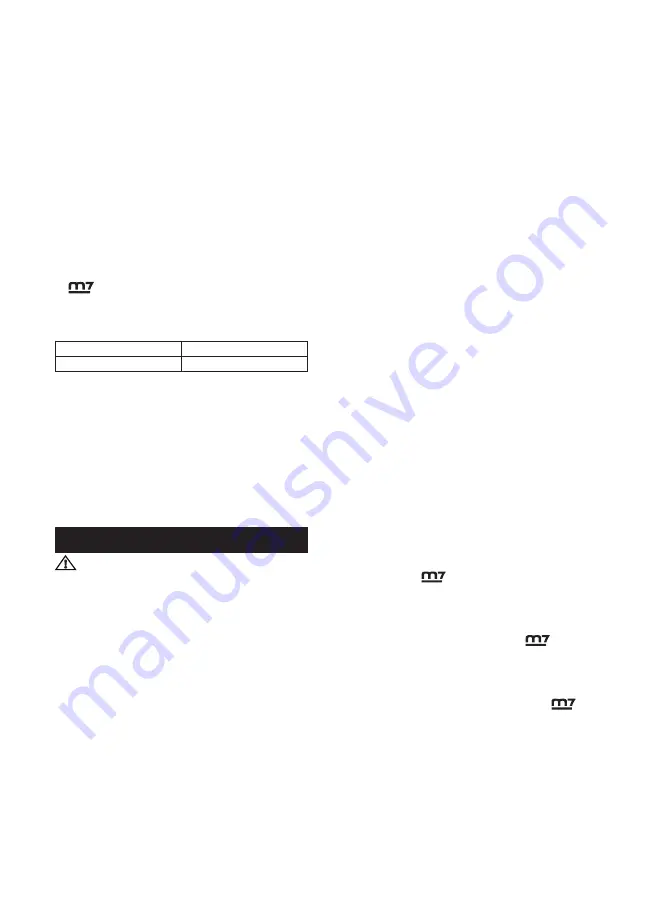
5
respiratory system.
5 .
When the battery is defective, liquid can
escape and come into contact with adjacent
components. Check any parts concerned.
Clean such parts or replace them, if required.
6 .
If liquid comes in contact with your
skin,wash immediately with soap and water,
thenneutralize with lemon juice or vinegar.
7 .
If liquid from the battery gets in your eyes,
flush them with clean water for at least 10
minutes, and then seek immediate medical
attention. Following this rule will reduce the risk
of serious personal injury.
8 .
Use the battery only in conjunction with your
power tool. This measure alone protects
the battery against dangerous overload.
9.
Use the battery only with the charger list,use
with other chargers could result in fire hazard.
BATTERY PACK
CHARGER
DB1813
DC01
10.
Do not crush, drop or damage the battery
pack. Do not use a battery pack or charger
that has been dropped or received a sharp
blow. A damaged battery is subject to
explosion. Properly dispose of a dropped or
damaged battery immediately.
11. Do not charger a battery tool in a damp or wet
location. Following this rule will reduce the risk
of electric shock.
SAFETY RULES FOR CHARGER
CAUTION:
To reduce the risk of electric
shock or damage to the charger and battery,
charge only those lithium-ion rechargeable
batteries as specifically designated on your
charger’s label. Other types of batteries may
burst, causing personal injury or damage.
1)
Before using battery charger, read all
instructions and cautionary markings in this
manual and on the battery charger, the battery
and the product using the battery to prevent
misuse of the products and possible injury or
damage.
2)
Do not use the charger outdoors or expose it
to wet or damp conditions. Water entering the
charger will increase the risk of electric shock.
3)
Use of an attachment not recommended or
sold by the battery-charger manufacturer may
result in a risk of fire, electric shock or injury to
persons.
4)
Do not abuse the cord or charger. Never use
the cord to carry the charger. Do not pull the
charger cord to disconnect the plug from
receptacle. Damage to the cord or charger
could occur and create an electric shock
hazard. Replace damaged cords immediately.
5)
Make sure that the cord is located so that it
will not be stepped on, tripped over, come in
contact with sharp edges or moving parts, or
otherwise subjected to damage or stress. This
will reduce the risk of accidental falls, which
could cause injury and damage to the cord,
which could then result in electric shock.
6)
Keep cord and charger from heat to prevent
damage to housing or internal parts.
7)
Do not allow gasoline, oils, petroleum-based
products, etc. to come in contact with plastic
parts. These materials contain chemicals that
can damage, weaken, or destroy plastic.
8)
An extension cord should not be used unless
absolutely necessary. Use of an improper
extension cord could result in a risk of fire and
electric shock. If an extension cord must be
used, make sure that:
The pins on plug of extension cord are the same
number, size and shape as those of the plug on
charger.
The cord is properly wired and in good electrical
condition
9)
Do not operate the charger with a damaged
cord or plug, which could cause shorting and
electric shock. If damaged, have the charger
repaired or replaced by an authorized service
technician at
.
10)
Do not operate the charger if it has received
a sharp blow, been dropped, or has otherwise
been damaged in any way. Take it to an
authorized service technician at
for an
electrical check to determine if the charger is
in good working order.
11)
Do not disassemble the charger. Take it to
an authorized service technician at a
when service or repair is required. Incorrect
reassembly may result in a risk of electric
shock or fire.
12)
Unplug the charger from the electrical outlet
before attempting any maintenance or
cleaning to reduce the risk of electric shock.
13)
Disconnect charger from the power supply
when not in use. This will reduce the risk of
electric shock or damage to the charger if











































